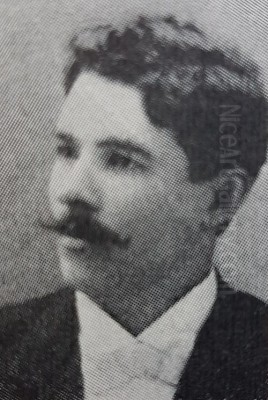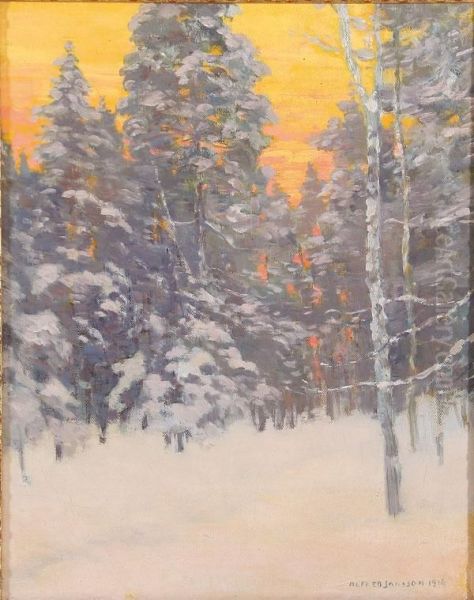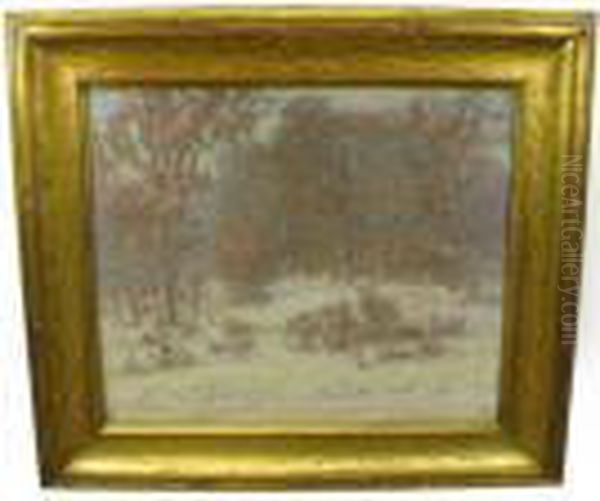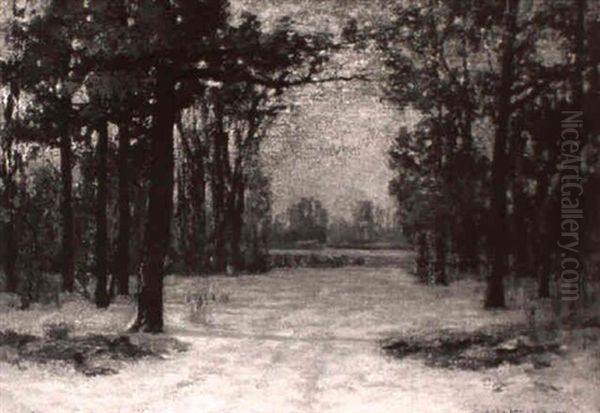
Alfred Jansson stands as a distinguished figure in the annals of American art, a Swedish-American painter who carved a unique niche for himself through his evocative and atmospheric depictions of winter landscapes. Immigrating to the United States and settling in Chicago, Jansson became a keen observer of the American Midwest, particularly its snow-laden terrains and the subtle interplay of light during the coldest months. His work, deeply rooted in the Impressionist tradition yet imbued with a Tonalist sensibility, captures not just the visual reality of winter but its profound emotional and poetic resonance. This exploration delves into the life, art, and enduring legacy of a painter who found endless inspiration in the quiet majesty of a world blanketed in snow and ice.
From Scandinavian Roots to American Soil: Jansson's Formative Years
Born in Kil, Värmland, Sweden, on August 11, 1863, Alfred Jansson's early life was steeped in the rich cultural and natural environment of Scandinavia. This region, with its dramatic seasonal shifts and deep appreciation for nature, undoubtedly played a role in shaping his artistic inclinations from a young age. His formal artistic training began in his homeland, where he attended the Technical School in Stockholm. He also spent a period at the prestigious Royal Swedish Academy of Arts, an institution that had nurtured many of Sweden's finest talents.
During his formative years in Sweden, Jansson was exposed to a vibrant national art scene. Artists like Anders Zorn, with his masterful depiction of light and human form, and Bruno Liljefors, renowned for his wildlife and nature paintings, were prominent figures. While Jansson would develop his own distinct style, the emphasis on capturing the essence of the natural world, a hallmark of Scandinavian art, likely left an impression. The allure of new opportunities and a burgeoning art world eventually led Jansson to make the life-altering decision to emigrate.

In 1889, Alfred Jansson arrived in the United States, choosing Chicago as his new home. At this time, Chicago was a rapidly expanding metropolis, a hub of industry, commerce, and increasingly, culture. The city was still rebuilding and redefining itself after the Great Fire of 1871, and there was a palpable energy and ambition that extended to the arts. For an immigrant artist like Jansson, Chicago offered a dynamic environment in which to further his studies and establish his career. He continued his artistic education at the School of the Art Institute of Chicago, refining his skills and absorbing the influences of the American art scene.
The Essence of Light and Atmosphere: Jansson's Artistic Style
Alfred Jansson's artistic style is primarily characterized by its Impressionistic approach, particularly in his handling of light and color to capture fleeting moments in nature. He was deeply fascinated by the optical effects of light on snow – the way it could sparkle, absorb color, or cast long, ethereal shadows. His canvases often feature broken brushwork, a technique synonymous with Impressionism, which lends a sense of immediacy and vibrancy to his scenes. Unlike some of his European Impressionist counterparts who focused on bustling cityscapes or leisurely countryside scenes, Jansson turned his gaze to the often-overlooked beauty of the winter landscape.
However, Jansson's work transcends a purely Impressionistic rendering. There is a strong Tonalist undercurrent that infuses his paintings with a profound sense of mood and atmosphere. Tonalism, an American artistic movement that emerged in the late 19th century, emphasized soft, diffused light, subtle color harmonies, and an overall evocative, often melancholic or spiritual, quality. This is particularly evident in Jansson's nocturnes and twilight scenes, where he masterfully depicted the hushed stillness of a snow-covered world under the glow of the moon or the fading light of day. Artists like George Inness and James McNeill Whistler were key proponents of Tonalism, and Jansson's work shares their concern for capturing an emotional response to nature rather than a mere literal transcription.
Jansson's unique talent lay in his ability to convey the sensory experience of winter – the crispness of the air, the muffled silence of a fresh snowfall, the stark beauty of bare trees against a luminous sky. He did not shy away from the harshness of the season but found in it a unique poetry. His palette, while capable of capturing the bright blues and whites of a sunny winter day, could also delve into muted grays, lavenders, and deep blues for his crepuscular and nocturnal scenes, creating a powerful emotional resonance. His technique involved careful observation, often painting en plein air to directly experience the conditions he sought to portray.
Canvases of Frost and Glow: Jansson's Signature Works

Alfred Jansson's oeuvre is distinguished by a consistent dedication to the theme of winter, explored through various times of day and atmospheric conditions. One of his most celebrated paintings is "Winter," which earned him the prestigious Martin B. Cahn Prize from the Art Institute of Chicago in 1914. This work likely exemplified his skill in capturing the interplay of light and shadow on a snow-covered landscape, showcasing his mature Impressionistic technique and his ability to evoke the serene yet formidable character of the season. Such recognition from a major institution underscored his standing within the Chicago art community.
Another significant piece often associated with Jansson is "A Gray Day." This title itself suggests a Tonalist sensibility, focusing on a specific atmospheric condition and its attendant mood. In such works, Jansson would have explored a more subdued palette, emphasizing the subtle gradations of light and the quietude of an overcast winter sky. Paintings like "The Frozen River" would have allowed him to explore the textures of ice and snow, the reflections on frozen surfaces, and the stark, sculptural forms of a landscape locked in winter's embrace. These scenes often convey a sense of solitude and introspection, inviting the viewer to contemplate the quiet beauty of the natural world.
His nocturnes, such as those titled "Moonlight on the Snow" or similar themes, are particularly compelling. In these, Jansson masterfully balanced the darkness of night with the reflective qualities of snow, creating scenes that are both mysterious and enchanting. The cool blues, violets, and silvers would dominate, punctuated perhaps by the warm glow of a distant light. Other representative titles that recur in discussions of his work include "Early Winter" and "Winter Sun," indicating his thorough exploration of the season's varied facets. While many of his works are in private collections, his paintings have been exhibited at prominent institutions, and their enduring appeal lies in their authentic and poetic portrayal of winter's soul.
Beyond the Easel: The Life of Alfred Jansson
Alfred Jansson's dedication to his craft was profound, particularly his commitment to capturing the authentic feel of winter. This often meant braving the harsh conditions of Chicago winters to paint en plein air. This practice, while challenging, allowed him to observe firsthand the subtle nuances of light, color, and atmosphere that were so crucial to his art. Such dedication speaks to a resilient and observant character, deeply connected to the subjects he chose to depict. While detailed personal anecdotes are not widely publicized, his professional life and contributions to the art community paint a picture of a focused and respected artist.

Jansson was an active participant in Chicago's burgeoning art scene. He was a member of the Palette and Chisel Club, a significant organization for artists in the city, providing a space for camaraderie, exhibition, and mutual support. He also belonged to the Chicago Society of Artists, further integrating him into the local artistic milieu. His Swedish heritage remained important, and he was involved with the Swedish-American Art Association, reflecting a desire to maintain cultural connections and support fellow artists from his homeland. This involvement suggests a sociable individual who valued community and artistic exchange.
His exhibition record was robust. Jansson frequently showed his work at the annual exhibitions of the Art Institute of Chicago, a key venue for American artists at the time. Beyond Chicago, his paintings were accepted into exhibitions at other prestigious institutions, including the Pennsylvania Academy of the Fine Arts and the National Academy of Design in New York. A notable achievement was winning a silver medal at the Panama-Pacific International Exposition in San Francisco in 1915, a major international event that brought significant recognition to participating artists. These accolades and exhibition opportunities attest to the quality of his work and its appreciation on a national level.
A Community of Vision: Jansson and His Contemporaries
Alfred Jansson did not create in a vacuum. He was part of a vibrant and evolving art world, both in his adopted city of Chicago and within the broader context of American art. The turn of the twentieth century was a dynamic period for American artists, many of whom, like Jansson, were grappling with how to apply modern European styles like Impressionism to distinctly American subjects and sensibilities.
In Chicago, Jansson was among a cohort of talented painters. Fellow Swedish-American artists such as Arvid Nyholm, known for his portraits and landscapes, and Charles Hallberg, a marine painter, were part of this community. While their subject matter might have differed, they shared a common heritage and the experience of forging artistic careers in a new land. Jansson's focus on winter landscapes set him apart, yet he was connected to a broader network. Other notable Chicago artists of the era included Frank Dudley, who became famous for his depictions of the Indiana Dunes, and Pauline Palmer, an accomplished Impressionist painter of figures and landscapes. Karl Albert Buehr, another Chicago-based Impressionist, also contributed to the regional strength of the movement. These artists, along with instructors and figures at the Art Institute like Charles Francis Browne, helped create a supportive and stimulating environment.
Nationally, Jansson's work resonated with the broader American Impressionist movement. While not a member of "The Ten American Painters" – a prominent group that included figures like Childe Hassam, John Henry Twachtman, and J. Alden Weir – Jansson's art shared their commitment to capturing light and atmosphere with a distinctly American voice. Twachtman, in particular, was known for his delicate and atmospheric winter scenes, and though their styles differed, they both found profound beauty in the snow-covered landscape. Willard Metcalf and Frank Weston Benson, also part of The Ten, similarly celebrated the American landscape through an Impressionist lens.
Jansson's Tonalist leanings also connected him to another significant thread in American art. The evocative, moody landscapes of George Inness, the atmospheric nocturnes of James McNeill Whistler, and the poetic works of Dwight William Tryon, Alexander Helwig Wyant, and Henry Ward Ranger all shared a concern for capturing the subjective experience of nature. Jansson's moonlit snow scenes, with their subtle gradations of color and emphasis on quietude, align closely with Tonalist ideals. It is more accurate to see Jansson as part of a collaborative artistic environment, where influences were absorbed and styles adapted, rather than a scene characterized by intense rivalries. His unique contribution was the application of these stylistic trends to the specific character of the Midwestern winter.
Impressionism's Northern Light: Jansson's Place in Art Movements
Alfred Jansson is firmly situated within the American Impressionist movement, yet his work possesses a distinct character shaped by his personal vision and his chosen subject matter. American Impressionism, which flourished from the late 1880s through the early 20th century, saw artists adapting the techniques and theories of their French counterparts – such as capturing the fleeting effects of light and color with broken brushwork and painting en plein air – to American landscapes, figures, and scenes of daily life. Jansson embraced these principles wholeheartedly, but directed them towards the unique challenges and beauties of winter in the American Midwest.
His contribution can be seen as a regional expression of Impressionism. While artists on the East Coast, like Childe Hassam or Willard Metcalf, depicted the New England countryside or bustling cityscapes, Jansson found his muse in the snow-covered fields, frozen rivers, and wooded areas around Chicago. He demonstrated that the Impressionist approach was versatile enough to capture the stark, sometimes harsh, beauty of a northern winter, transforming it into scenes of poetic tranquility and visual delight. His focus on the specific atmospheric conditions of winter – the crisp light of a sunny day, the diffused glow of an overcast sky, the ethereal shimmer of moonlight on snow – was a hallmark of his Impressionistic practice.
Simultaneously, Jansson's art aligns significantly with Tonalism. This movement, often seen as a bridge between the Hudson River School's detailed naturalism and the more abstract tendencies of modernism, emphasized mood, spirituality, and harmonious color schemes. Jansson's nocturnes and twilight scenes, with their limited palettes, soft edges, and emphasis on quiet contemplation, are prime examples of Tonalist influence. This blending of Impressionistic technique with Tonalist mood was not uncommon among American artists of his generation, who sought to create art that was both visually engaging and emotionally resonant. Figures like John Henry Twachtman also produced works that beautifully merged these two sensibilities.
Jansson's Swedish heritage may also have subtly influenced his artistic perspective. Scandinavian art often displays a deep reverence for nature and a sensitivity to the dramatic effects of light in northern latitudes. While he adopted American styles, this underlying sensibility could have informed his profound connection to the winter landscape. As a Swedish-American artist, he contributed to the rich, multicultural tapestry of American art, bringing a unique perspective to the shared endeavor of interpreting the American experience through visual art. He was not merely an imitator of European trends but an innovator who forged a personal style suited to his environment and his artistic temperament.
The Enduring Chill: Legacy and Appreciation
Alfred Jansson passed away in Chicago on July 28, 1931, leaving behind a significant body of work that continues to be appreciated for its sensitive and skillful portrayal of winter. His legacy is that of a specialist, an artist who dedicated much of his career to exploring the myriad facets of a single season, finding in its apparent starkness an endless source of beauty and artistic inspiration. He earned a lasting reputation as one of America's premier painters of snow, a "poet of winter" whose canvases evoke the quiet magic and profound stillness of the season.
In the decades since his death, Jansson's paintings have maintained their appeal, particularly among collectors and institutions specializing in American Impressionism, Tonalism, and regional art of the Midwest. His work is valued not only for its aesthetic qualities – the masterful handling of light, color, and atmosphere – but also for its authentic depiction of a specific American landscape and climate. His paintings offer a window into the Midwestern environment at the turn of the 20th century, captured through the eyes of an artist with a deep empathy for its character.
While it may be difficult to trace direct lines of influence on specific subsequent painters, Jansson's success and dedication to the winter theme undoubtedly contributed to a broader appreciation for such subjects within American art. He demonstrated that winter, often perceived as a barren or inhospitable season, was rich with artistic possibilities. His commitment to en plein air painting, even in challenging conditions, set an example of artistic rigor and dedication to direct observation.
The timeless appeal of Alfred Jansson's art lies in its ability to connect with viewers on an emotional level. His winter scenes are more than just topographical records; they are mood pieces that evoke feelings of peace, solitude, and contemplation. In a world that is often loud and fast-paced, his quiet, evocative landscapes offer a sense of respite and an invitation to appreciate the subtle beauty of the natural world. Alfred Jansson's enduring contribution to American art is his unique and poetic vision of winter, a vision that continues to resonate with audiences and secure his place as a master of light and snow.